Home
Ren's Biking Blog
BMW G310R First Look
Blog Date 11 May 2017
After what seems like quite a long time the BMW dealership in Preston has got a couple of G310Rs on display. While passing through I thought I'd drop in and take a look at them and see what I think.
If you'd come across this bike in 2005 you might have been impressed by the design and the angular lines but as I stand before it I am neither impressed or taken aback by it's looks, I'm completely indifferent to it. The only thing that sets it apart are the surroundings, it looks a little out of place among the S1000RRs, GS1200s and R-NineTs. If this were a Suzuki Yamaha Kawasaki dealers it would blend in rather than stand out. It looks fine just not special.

It's a bike. Definitely a motorcycle.
Has BMW done anything to set this bike apart from the competition? The swing arm echoes KTM's Duke as well as the big white rear spring in plain sight. It sports the shoulder pads and hunched up mean look of just about every modern street bike these days (KTM Duke, Kawasaki Z range and so on). Exposed steel tube frame a-la Duke, Z250SL, Ducati. There's even a little belly pan thing. If anyone reading could explain - is there a practical purpose to a belly pan or are they just dressing?

This just looks strangely familair.
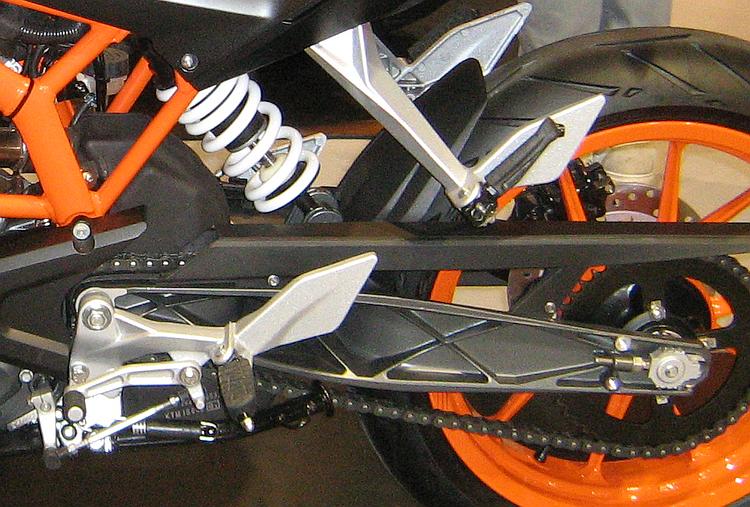
Not the same...just similar.
So looks wise it's BMW's answer to the KTM Duke with a few minor alterations to avoid copyright. Except it doesn't manage to pull off KTM's mean, aggressive and distinctly orange looks.
There is one thing that does set the G310R apart from almost all other motorcycles and that's the erm...I guess you'd call it a reverse layout of the top end. The exhaust exits from the rear of the cylinder head and the inlet is at the front behind the radiator. I'm sure there are some layout and technological advantages to this but as it the way of things for every pro there's a con. I don't know why BMW chose to do this but it is at least interesting, it makes me want to take it apart and work it all out.
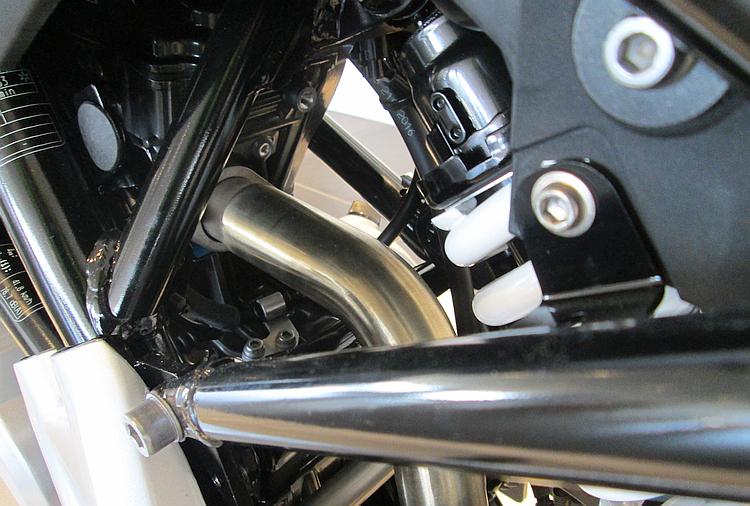
"Ere mate, thas put th'ead ont wrong way round"
Taking a closer look it becomes possible to see this bike is built to a price. The casting at the bottom of the fork lacks finesse. The front brake lever looks like an aftermarket replacement from eBay. The paint on the engine cases is flat and lifeless. The switchgear plastic also seems flat and lifeless. When I compare it to how Sharon's Z250SL Kawasaki looks and feels the difference is palpable and her bike is considerably cheaper. Are we just paying for the badge?
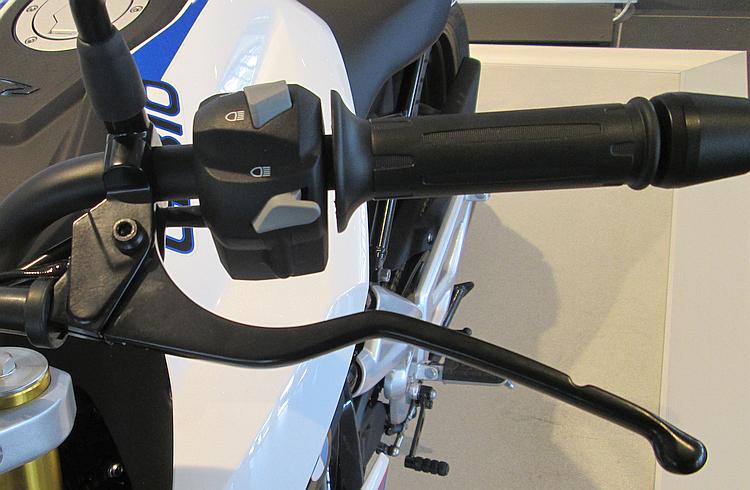
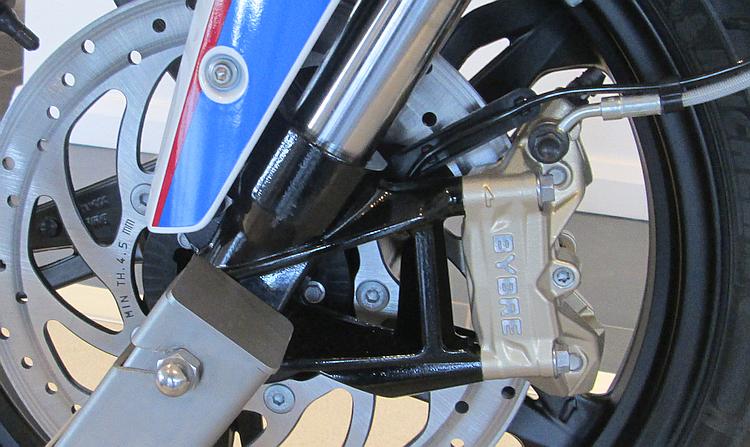
There nothing wrong at all, just nothing special either.
There are some blatantly obvious good points though. No rear linkage which means less to go wrong and the difference in handling is negligible to we ordinary mortals. Stainless exhaust is a must on all but the cheapest motorcycles these days. Upside down forks are nice although again for we ordinary mortals I've yet to be convinced they're necessary. I also like the way a section of the front sprocket is visible making it easy to keep an eye on the wear.
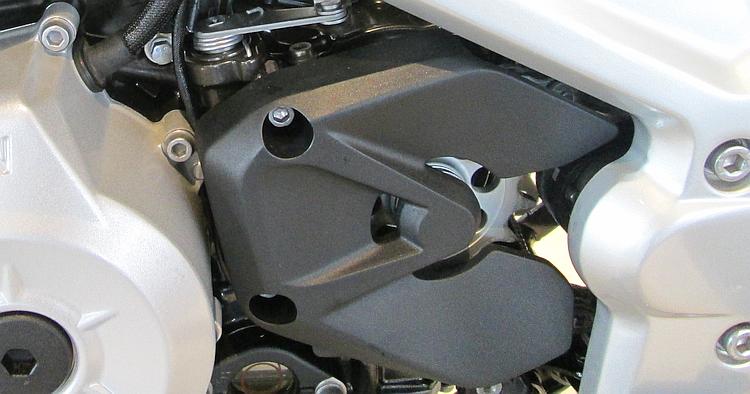
I like to know what state my front sprocket is in.
Being a fan of smaller capacity machines I want to like this bike. The 310cc single should have nice poke and more than enough speed for legal limits while being frugal. 158.5kg wet weight ain't too bad. I'm just left with a sensation of "so what?" when the competition is every bit the equal if not ahead. If I were looking for run of the mill I wouldn't expect it from BMW, BMW with their premium price tag ought to be a little special.
But...perhaps that is the point of this bike? When I first became involved with motorcycling my perception of the world saw BMW as a marque apart from the rest of them. They were owned by motorcyclists not greasy bikers. They were impeccably maintained by gentlemen in smartly pressed overalls rather than grease monkeys. They were also a little too expensive to be purchased by the great unwashed such as myself.
Since those days along came Ewan and Charlie who promoted the GS1100 to wannabe world weary travellers. This seemed to spur BMW into modernising and becoming trendy. That lead to ridiculous models like the S1000RR (rrrrrrrrrr) in an attempt to capture the sports rider's need for speed and super tourers like the 6 cylinder K1600GT. All these models are seriously expensive, the G310R while being a little more costly than the competition is erm, errr, affordable. And ordinary.
Is it wise for BMW to emulate the competition? On the one hand if they don't move with the times they'll be left behind. On the other hand if they become just like everyone else they'll have to fight and squabble over mainstream customers just like everyone else. They're the ones making millions so I'm hardly in any position to advise.
What remains to be seen is how well it rides. Perhaps that will set it apart from the rest of the bunch.
What are your thoughts? You can add them in the comments below or if you have enough to put an article together then Click Here.
Reader's Comments
Doug said :-
I seem to remember reading about the design for the original Mini, which had the carb at the front and the exhaust at the rear, but they had to turn the engine 180 degrees because of carb icing problems (and losing something like 10% of the power in the extra gearing required to achieve it).
I'm guessing that with fuel injection icing isn't an issue, and can maybe make use of a more "forced" airflow? Will be interesting to see how it works out.
11/05/2017 22:10:16 UTC
Ren - The Ed said :-
The ram-air effect has been done several times before, you'll find several sports bikes with air intakes on the nose of the bike, it doesn't require a reverse layout. There's no obvious signs of an intake in a prominent position for ram air anyhow.
I suspect it's more to do with packaging, weight distribution and just for the sheer hell of it.
To the best of my limited knowledge I don't believe fuel injection does suffer icing. There's one advantage of modern technology at least.
11/05/2017 22:29:33 UTC
Ian Soady said :-
The problem with "forced" airflow is that the pressure is related to the square of the bike's road speed which bears little relationship to the power requirements. For example, it's zero when you want a lot of power to take off, and is maximum when you're shutting off for Creg ny Baa.....
Forward facing carbs for racing machines were tried and quickly dropped by many manufacturers in the 50s. I'm not convinced that the air intakes we see on the bikes Ren mentions are to increase intake pressure, merely that it's a convenient place to put them. And of course a further advantage of fuel injection is that airbox pressure is monitored so the fuel input can be adjusted.
WRT the Mini, I can tell you from experience that carb icing was a real problem with the rear-facing carb layout.
12/05/2017 09:41:40 UTC
Ren - The Ed said :-
At very high speeds the forced air may make a small difference, I couldn't say how much though. Considering the 310 will likely have a top speed of around 90mph I doubt the reverse engine layout had anything to do with forced air.
12/05/2017 16:40:29 UTC
Matty said :-
I've been interested in this bike hitting the showrooms for a while now. It is a BMW - well it's designed by BMW but its actually built in India (as some KTMs are too I guess) by a company called TVS https://www.tvsmotor.com/ - and I think the first BMW to be built outside Europe? So maybe that explains some of the feel/look of the components?
13/05/2017 21:50:43 UTC
Ren - The Ed said :-
You're absolutely right Matty. I deliberately didn't mention this in the post because I don't think it matters where a motorcycle is made these days. While a motorcycle may be built in Japan, Europe or America the parts probably come from all around the world.
If BMW are putting their badge on a motorcycle from Bavaria or Delhi or Mombassa they are still putting their reputation on that model too. There's no reason an Indian factory can't be every the equal to a German one, it's up to BMW to ensure as such.
I currently own an early CBF125 made in India and that's fine. My CB500X was made in Thailand and that's fine. I'm sure the G310R will also be fine but there's a tangible difference in finish from the current BMWs.
What I do hope is that the G310R is a success. Here in the spoilt fat countries we need to move away from this mentality that to be a real biker you need at least 1000cc. I hope it handles like a MotoGP bike, sips fuel, is totally reliable and more fun on real roads than any CBZXGSYZRRR 1000 RRRRrrrrr.
14/05/2017 05:33:52 UTC
John said :-
Like yourself I want to like this BMW, but looking at the engine layout it appears as if you would need to dismantle half the bike to check the valve gap. If this is the case, basic services would be very expensive?
I love your site, real world comments and common sense, using bike's with budgets I can relate to.
18/05/2017 07:42:58 UTC
Ren - The Ed said :-
Thanks John. I would of course like to have the top end budget but I'm too lazy to actually earn the pennies.
I cannot comment on how hard it will be to get to the cylinder head and the valve clearances. That said my CB500X is a goddam blasted nightmare to get to the valves so I doubt the G310R could possibly be worse.
It would be good to know both the service interval for the valve clearances and the cost both from BMW dealerships and local trustworthy workshops. Sometime soon someone somewhere will do a "how to" and we'll be able to judge for ourselves.
18/05/2017 09:32:33 UTC
Ted said :-
CB500X....Valve clearances, 1st Service...DONE! September 2017
well the 2016 CB500X that I bought a few months back with the massive 379 miles on the clock has finally got to 600 and was ready for its first service.
Was I going to a Honda dealer and paying the (Alleged) £600.00
Sharp intake of breath, 2 steps back...."THIS IS GONNA COST YA GUVNOR!"
I don't think so....there are a couple of bike shops in the Wisbech (it's Cambridgeshire/Norfolk)and I always go to see Joe Barnes of JB Bikes.
jbbikes.co.uk or 01945 474774
I'm not sure the lads want another in to work on is any great hurry ;-)
YES, the shims did need checking, YES, Two were way too tight and Joe being the genuine guy he is, managed to use one of my old shims to get another gap correct, so it only cost me for one shim.....and the labour for doing such a bastorial job.
Soooooo, bottom line price, with genuine Honda filter and decent oil....£222.08.
Where the £0.08 p came from is anyone's guess.
OH, Word of warning, be prepared for a bit of banter.....
They dish it out and can take it.
I asked Joe " Do you know what a day without sarcasm would be like?"
NO, neither do I ;-)
20/09/2017 15:52:00 UTC
pocketpete said :-
I didnt think the shims needs doing a 600 miles they are only down for being done at 16K miles.
600miles is an oil/filter replacement and check over
8000miles is basically the same with a few extra bits
then 16000 the big shim party -
20/09/2017 18:54:01 UTC
Ren - The Ed said :-
I agree Pocketpete, according to my manual and the dealership they ain't due until 16,000 miles. BUT! The first models were all given a tappets check at the initial 600 service, Honda being overcautious.
But if the tappets were out it's a good job they were done!
A day without sarcasm is a day not worth living.
20/09/2017 20:05:46 UTC
Pocketpete said :-
Ah yes just had a look on the forum seems honda were cautious when the bike was first released. An early shim check was needed. 2016 onwards they appear to have had a rethink and were now happy with the engine to allow it to go to 16k.
Interesting to see if it makes any difference in long term use.
21/09/2017 07:21:39 UTC
Ian Soady said :-
I do find it very surprising that a modern motorcycle would have allowed the clearances to tighten up in 600 miles.
21/09/2017 09:26:16 UTC
Ren - The Ed said :-
When Honda first released the 500 range they all required the tappets checking at 600 miles. The suggestion on the internet was Honda weren't so sure about the new motor and the new manufacturing facilities, as such we the customer were acting as research and development. Not good.
It transpired that almost all of the motors didn't require the tappet check so later models didn't require it.
It's perfectly possible that Ted's 500 slipped the net. We don't know the whole story.
21/09/2017 10:31:28 UTC
Borsuk said :-
Let the public pay to be your quality control. Sounds like a chapter out of the Microsoft Business Plan.
21/09/2017 15:03:40 UTC
Name
Comment
Add a RELEVANT link (not required)
Upload an image (not required) -
Uploading...
Home
Ren's Biking Blog